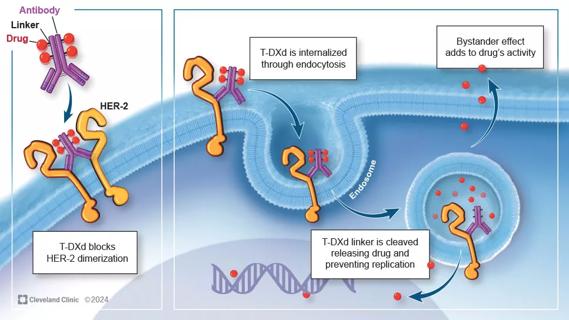NCCN guidelines include ruxolitinib use

Good news for oncologists seeking the latest information on how to treat myeloproliferative neoplasms (MPNs), including myelofibrosis (MF), polycethemia vera (PV) and essential thrombocythemia (ET).
Advertisement
Cleveland Clinic is a non-profit academic medical center. Advertising on our site helps support our mission. We do not endorse non-Cleveland Clinic products or services. Policy
The National Comprehensive Care Network has released its inaugural set of diagnostic, treatment and supportive care guidelines for MF and intends to update with similar information on PV and ET later this year.
Cleveland Clinic Taussig Cancer Institute’s Aaron Gerds, MD, MS, helped draft the guidelines as a member of both the panel and the Discussion Writing Committee. He explains here why the guidelines were developed, how to use them and what it is like to be a part of the panel.
“The nice thing about the NCCN guidelines is that no matter what disease you’re looking at, the format and flow are relatively the same,” says Gerds. “Physicians will already be familiar with the guidelines’ format and can open the MPF Guidelines and know exactly how to use them.”
MPNs constitute a relatively rare constellation of hematological cancers, and are also called Philadelphia chromosome-negative myeloproliferative neoplasms to distinguish them from chronic myeloid leukemia. Prevalence of MF, ET and PV in the United States is estimated to be approximately 13,000, 134,000 and 148,000, respectively.
A community oncologist in a smaller practice may see only a few cases of myelofibrosis a year, and the NCCN guidelines are designed to serve as a quick reference to help give that doctor at-a-glance access to the latest information.
“These diseases are not terribly common, so having a reference like the NCCN guidelines is very important,” says Gerds. “When you have a visit with a patient who has a disease you see so rarely, it’s great to have these guidelines.”
Advertisement
Low disease prevalence and a complicated symptom profile can make MPNs difficult to identify and treat. However, early diagnosis and appropriate treatment is important to avoid complications, such as thrombosis, and because of increased risk of progression to acute myeloid leukemia, which is associated with a poor response to therapy and short survival, according to the guidelines.
The symptom profile varies within and among each MPN subtype but often includes constitutional symptoms, such as fatigue, pruritus, weight loss and symptoms from splenomegaly, in addition to variable lab abnormalities, including erythrocytosis, thrombocytosis and leukocytosis. Definitive diagnosis requires a combination of clinical, laboratory and genetic testing.
Adding to the utility of the NCCN guidelines, specific treatment recommendations for MPNs have been developed by some of the world’s leading hematologists, including Dr. Gerds.
Among the recommendations in the MPN guidelines are suggestions for physicians on when to consider prescribing ruxolitinib, a Janus kinase inhibitor with selectivity for JAK1 and JAK2, which was approved for MF treatment by the FDA in 2011.
The drug has shown high efficacy in alleviating symptoms in patients with higher-risk MF and may increase survival, but it has yet to be evaluated in low-risk patients. However, practicing oncologists might not see many patients with myelofibrosis—or MPNs in general—and might not necessarily know when or how to use this medication. The guidelines can help them through this process.
Advertisement
Further, use of ruxolitinib can impose significant side effects, including reactivation of hepatitis and shingles infections, in addition to impairing liver and kidney function. Patients should be screened for these and other conditions before and during use of the drug.
Regarding the use of precision medicine and molecular testing in treatment of MPNs, Gerds says the panel ultimately took a conservative, evidence-based approach to issuing the final recommendations.
“During development, the team had a lot of discussion on how to incorporate molecular mutations into diagnosis and treatment recommendations,” says Gerds. “We’re still learning how to use these new tools, and it didn’t feel appropriate to include in the treatment recommendations. Ultimately, decisions on what to include came down to an evidence-based approach.”
Treatment guidelines for ET and PV are currently under development by the same 24-member panel, and Gerds is a member of the PV Subcommittee. He expects recommendations for those subgroups of MPNs to be complete sometime this year.
Guidelines for MPNs will continue to be updated regularly to include the latest diagnostic and treatment recommendations. Copies of the guidelines can be downloaded for free from the NCCN website.
Advertisement
Advertisement

First-of-its-kind research investigates the viability of standard screening to reduce the burden of late-stage cancer diagnoses

Study demonstrates ability to reduce patients’ reliance on phlebotomies to stabilize hematocrit levels

Findings highlight an association between obesity and an increased incidence of moderate-severe disease

Cleveland Clinic Cancer Institute takes multi-faceted approach to increasing clinical trial access 23456

Key learnings from DESTINY trials

Gene editing technology offers promise for treating multiple myeloma and other hematologic malignancies, as well as solid tumors

Study of 401,576 patients reveals differences in cancer burdens as well as overall survival

Enfortumab plus pembrolizumab reduced risk of death by 53% compared with platinum-based chemotherapy